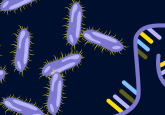Identifying T cells: the first step to developing successful immunotherapy for peanut allergies

Researchers have devised a novel technique to isolate and sequence the RNA of T-cells that react to a specific target, which they are using to develop and monitor new treatments for peanut allergies.
Researchers from the Massachusetts Institute of Technology (MA, USA) have developed a way to identify T-cells that react to a specific target, through RNA sequencing. Profiling these T-cells reveals their unique function by determining which genes they turn on at what given time.
This method, described in a recent study published in Nature Immunology, builds on the team’s previous research in developing techniques for rapid single-cell RNA sequencing of large populations of cells and successfully applies this to T-cells.
Previous attempts to perform RNA sequencing on T cells have been unsuccessful in determining the sequence of the T-cell receptor (TCR). This is because single-cell RNA sequencing usually only tags and sequences one end of each RNA molecule and most of the variation in TCR genes is found at the end of the molecule that does not get sequenced.
“For a long time, people have been describing T cells and their transcriptome with this method, but without information about what kind of TCR the cells actually have,” stated lead author Ang Tu. “When this project started, we were thinking about how we could try to recover that information from these libraries in a way that doesn’t obscure the single-cell resolution of these datasets and doesn’t require us to dramatically change our sequencing workflow and platform.”
The team were able to develop a way to isolate the specific part of the T-cell RNA that encodes for the TCR, which allowed it to be fully sequenced. Each RNA molecule was tagged with a barcode that allowed researchers to identify which cell it came from and match up the T-cell target with their RNA expression.
- Go nuts for peanuts
- Gut instinct: how to treat allergies
- RNA Sequencing; as accurate as once believed?
“To put the function of T cells into context, you have to understand what it is they’re trying to recognize,” explained co-author Alex Shalek. “This method lets you take existing single-cell RNA sequencing libraries and pull out relevant sequences you might want to characterize. At its core, the approach is a straightforward strategy for extracting some of the information that’s hidden inside of genome-wide expression profiling data.”
Utilizing this method, the researchers then analyzed T cells from four patients diagnosed with peanut allergies. This allowed them to identify the T cells that produced the inflammation observed in patients with peanut allergies.
“Food allergies affect about 5% of the population, and there’s not really a clear clinical intervention other than avoidance, which can cause a lot of stress for families and for the patients themselves,” explained co-author Christopher Love. “Understanding the underlying biology of what drives these reactions is still a really critical question.”
Love’s lab is now working in collaboration with researchers at Massachusetts General Hospital (MA, USA), to apply this technique to monitor the immune responses of patients undergoing oral immunotherapy for peanut allergies. The team hopes that this technique could help to predict how patients will respond to the treatment.
However, the team believes that the method could be applied much further than just allergies. Shalek’s lab is actively applying this strategy to identify T cells involved in fighting infectious diseases, such as HIV and tuberculosis. The researchers also believe that this research could be utilized in developing and monitoring immunotherapy treatments for cancer.





